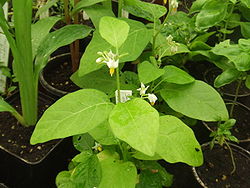Solanum aethiopicum
| Ethiopian nightshade {{{status}}} Fossil range: {{{fossil_range}}}
| ||||||||||||||||||||||||||||||||||||||||||||||||||||||||||||||||||
|---|---|---|---|---|---|---|---|---|---|---|---|---|---|---|---|---|---|---|---|---|---|---|---|---|---|---|---|---|---|---|---|---|---|---|---|---|---|---|---|---|---|---|---|---|---|---|---|---|---|---|---|---|---|---|---|---|---|---|---|---|---|---|---|---|---|---|
 | ||||||||||||||||||||||||||||||||||||||||||||||||||||||||||||||||||
| Plant Info | ||||||||||||||||||||||||||||||||||||||||||||||||||||||||||||||||||
| ||||||||||||||||||||||||||||||||||||||||||||||||||||||||||||||||||
| Scientific classification | ||||||||||||||||||||||||||||||||||||||||||||||||||||||||||||||||||
| ||||||||||||||||||||||||||||||||||||||||||||||||||||||||||||||||||
| [[{{{diversity_link}}}|Diversity]] | ||||||||||||||||||||||||||||||||||||||||||||||||||||||||||||||||||
| {{{diversity}}} | ||||||||||||||||||||||||||||||||||||||||||||||||||||||||||||||||||
| Binomial name | ||||||||||||||||||||||||||||||||||||||||||||||||||||||||||||||||||
| Solanum aethiopicum L. | ||||||||||||||||||||||||||||||||||||||||||||||||||||||||||||||||||
| Trinomial name | ||||||||||||||||||||||||||||||||||||||||||||||||||||||||||||||||||
| {{{trinomial}}} | ||||||||||||||||||||||||||||||||||||||||||||||||||||||||||||||||||
| Type Species | ||||||||||||||||||||||||||||||||||||||||||||||||||||||||||||||||||
| {{{type_species}}} | ||||||||||||||||||||||||||||||||||||||||||||||||||||||||||||||||||
| {{{subdivision_ranks}}} | ||||||||||||||||||||||||||||||||||||||||||||||||||||||||||||||||||
| [[Image:{{{range_map}}}|{{{range_map_width}}}|]] | ||||||||||||||||||||||||||||||||||||||||||||||||||||||||||||||||||
| Synonyms | ||||||||||||||||||||||||||||||||||||||||||||||||||||||||||||||||||
| {{{synonyms}}} |
Ethiopian nightshade or nakati is a fruiting plant of the Solanum genus found in Asia and Tropical Africa. It is also known as mock tomato, Ethiopian eggplant and scarlet eggplant. These names are a result of its varied morphology, with ripe fruit often looking like a cross between an eggplant and a tomato, which are also from Solanum.
Contents |
Origins
Solanum aethiopicum may have originated from the domestication of Solanum anguivi.
Uses
The leaves of Solanum aethiopicum are eaten as a leaf vegetable and are more nutritious than the fruit.
The highly variable fruit of the plant is eaten both raw and cooked and is becoming more popular as a cultivated crop. These fruits are usually harvested while still green, before the skin becomes thick. The bitterness depends on the levels of saponin it contains, some with a sweet flavor and others very bitter. When the berries mature, they turn bright red because of high carotene content.
Solanum aethiopicum is used as an ornamental in Asia.
Cultivation
Currently there is a large movement towards increased cultivation of Solanum aethiopicum in West Africa. It grows all year long and can produce high fruit yields. However, low germination rates are an obstacle to wider cultivation.
In South Italy, exatly in Rotonda (Basilicata), there is a small population. Propably it was introduced by veterans came back from West Africa after the colonial war (in the ending of XIX).
Cultivars
- “Turkish Orange” or “Turkish Italian”
- The fruits of this variety are about two inches in diameter and turn bright orange-red when ripe, although they are usually eaten when still green. The sweet taste is often used in Thai curry. It can produce fruit within just 75 days after planting.
- “Sweet Red”
- These striped fruits, just 1 inch in diameter, have a strong but non-bitter flavor. The plant is thornless and grows up to 3 feet tall and can produce fruit 125 days after planting.
- “Small Ruffled Red”, “Red Ruffles”, or “Hmong Red”
- The two-inch berries of the Hmong Red have deep creases and a bitter flavor used in Southeast Asian cooking. It can produce fruit 100 days after planting.
